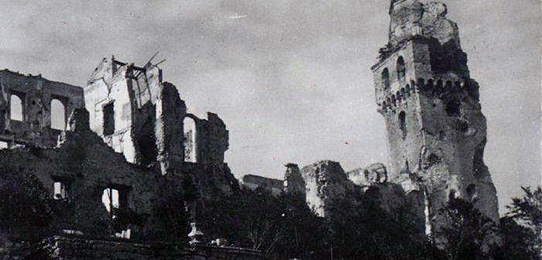You are here: HOME >> PLACES AND REGIONS >> CARD
Places and regions / San Salvatore Castle / Susegana
The great War

Outline of the place:
An important committal residence in the history of Veneto, the castle of San Salvatore has for centuries controlled the connection line between the Treviso hills and the plain and the long area of rivers and the ferries on the Piave. It was ferociously shelled by the Italian and British artillery due to the considerable quantity of enemy preparations located in the immediate vicinity: its visible and massive structure was also an optimal target for the firing tests of the batteries that used it to adjust the shots on surrounding objects. The base of the castle has numerous tunnels dug by the Austro-Hungarians, which were also partly reused in the World War II.
Not to be missed:
Vittorio Veneto / Palazzo Minucci.
The castle preserves the legacy of Giacomo Camillo De Carlo, a highly decorated aviator in World War I for having parachuted, for the first time in history, behind the front lines of the adversary to act as a spy. Companion in arms of D’Annunzio for his aesthetic taste and his way of interpreting life, he bequeathed the city of Vittorio Veneto a small “Vittoriale” memorial collection as testimony to the aesthetic and ethical tastes of the day.
Refrontolo - Tempietto Spada.
Built in a dominating position in 1800, this temple was the object of artillery shots and was destroyed by shelling in 1918.
Susegana / Colle della Tombola Observatory.
The hill rises above the Piave facing the Montello, in an ideal position for observing the Italian lines. The trenches, still recognizable today, surrounded the prehistoric castelliere (fortified village) and were positioned at distances between observatories and first aid cave shelters, which were valorously held until the end by the Hungarian infantry of the 51st division Honvéd.
Collalto / Ca' del Montone.
Two plaques, one in Italian and the other in Czechoslovakian, are affixed on the external wall of this farmhouse, which was a command headquarters during the conflict, to commemorate the execution of a number of Czechoslovakian legionnaires taken prisoner during the battle of Solstice. Many Czechs joined the Italian appeals and left the front to fight for the liberation of their homeland from the Hapsburg dominium: they were considered deserters and, if taken prisoner, were condemned to execution.
Collalto / Goiginger Observatory.
The hills of Guarda were one of the places most suited to observation with extensive views from Montello to the plains of the Quartier del Piave. The hills were chosen as the main observatory by Field Marshall Ludwig Goiginger, commander of the XXIV army corps and in charge of the offensive action on Montello during the battle of Solstice . He was the only commander decorated with the Ordine di Maria Teresa, in all of the centuries of the Austrian Empires military history for having carried out a withdrawal under almost impossible conditions.
An important committal residence in the history of Veneto, the castle of San Salvatore has for centuries controlled the connection line between the Treviso hills and the plain and the long area of rivers and the ferries on the Piave. It was ferociously shelled by the Italian and British artillery due to the considerable quantity of enemy preparations located in the immediate vicinity: its visible and massive structure was also an optimal target for the firing tests of the batteries that used it to adjust the shots on surrounding objects. The base of the castle has numerous tunnels dug by the Austro-Hungarians, which were also partly reused in the World War II.
Not to be missed:
Vittorio Veneto / Palazzo Minucci.
The castle preserves the legacy of Giacomo Camillo De Carlo, a highly decorated aviator in World War I for having parachuted, for the first time in history, behind the front lines of the adversary to act as a spy. Companion in arms of D’Annunzio for his aesthetic taste and his way of interpreting life, he bequeathed the city of Vittorio Veneto a small “Vittoriale” memorial collection as testimony to the aesthetic and ethical tastes of the day.
Refrontolo - Tempietto Spada.
Built in a dominating position in 1800, this temple was the object of artillery shots and was destroyed by shelling in 1918.
Susegana / Colle della Tombola Observatory.
The hill rises above the Piave facing the Montello, in an ideal position for observing the Italian lines. The trenches, still recognizable today, surrounded the prehistoric castelliere (fortified village) and were positioned at distances between observatories and first aid cave shelters, which were valorously held until the end by the Hungarian infantry of the 51st division Honvéd.
Collalto / Ca' del Montone.
Two plaques, one in Italian and the other in Czechoslovakian, are affixed on the external wall of this farmhouse, which was a command headquarters during the conflict, to commemorate the execution of a number of Czechoslovakian legionnaires taken prisoner during the battle of Solstice. Many Czechs joined the Italian appeals and left the front to fight for the liberation of their homeland from the Hapsburg dominium: they were considered deserters and, if taken prisoner, were condemned to execution.
Collalto / Goiginger Observatory.
The hills of Guarda were one of the places most suited to observation with extensive views from Montello to the plains of the Quartier del Piave. The hills were chosen as the main observatory by Field Marshall Ludwig Goiginger, commander of the XXIV army corps and in charge of the offensive action on Montello during the battle of Solstice . He was the only commander decorated with the Ordine di Maria Teresa, in all of the centuries of the Austrian Empires military history for having carried out a withdrawal under almost impossible conditions.
Copyright 2010 - Regione del Veneto - Site Map



 top
top info
info print
print